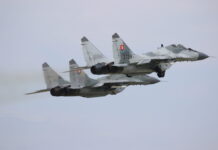Air-to-air refuelling (AAR) is a major force multiplier, enabling range, payload and combat radius extension of receiving aircraft.
The two main refuelling systems are “probe and drogue” and the boom. During the Cold War, AAR was limited to support long-range strategic forces, which is one of the main reasons why both France and the UK has operated tankers for so many years. Most of the other NATO members assumed that their respective air forces would operate much closer to home. After the end of the Cold War there has been a need to train for expeditionary operations, beyond the North Atlantic’s geographical domain. The lessons learnt from Operation Allied Force, when NATO attacked Yugoslavia from bases usually in Italy was that there simply weren’t enough AAR assets. A 2011 Joint Air Power Competence Paper said: “Current NATO policy holds individual nations responsible for the training, maintenance and deployment of their forces to and from an area of operations. AAR is critical to both the success of the deployment and any concurrent operations; to deploy the forces in a timely manner, in minimising both the logistic footprint and the chances of ground aborts during transits, and in maintaining a high tempo of operations. With the challenges associated with EO, AAR’s role as a Force Multiplier has become increasingly important.”
Smaller Nations Issues
All of NATO’s fighter pilots are expected to be qualified in air-to-air refuelling (AAR), but not every country has a defence budget big that can afford tanker aircraft. Nowadays even some of the bigger nations find it difficult to maintain their own AAR capability, so if the likes of France, Germany, Italy, The Netherlands, Spain, Sweden and the UK which have their own air to air refuelling assets find it difficult, what hope is there for the smaller nations?
The air forces of Hungary and Czech Republic both field a small fleet of GRIPENs and their pilots suffer because they do not get the AAR currency needed. There are no pilots current in AAR within the Hungarian Air Force, while the Czechs have two. The latter got some AAR training in, with a Swedish Air Force C-130H when four GRIPENs were deployed to Sweden for a live firing exercise in April.
The Czech Air Force GRIPENs did get some AAR currency in May 2018 during Exercise Sky Avenger when a pair of USAF/Nebraska ANG KC-135Rs deployed to Pardubice, Czech Republic. But that has now expired. They were supposed to get some time with a deployed KC-135R in April but that fell through and the sole Swedish C-130H tanker was due to visit Caslav in May but that went the same way.
Lt Col Pavel ‘Speedy’ Pavlik, the Operations Officer at Caslav told the author in July: “Tanker training has been difficult to execute although we have a couple of pilots who are current.” ‘Speedy’ also led the Czech Air force GRIPEN detachment to Estonia, for Baltic Air Patrol: “There will be some NATO tankers available there which we hope to operate with, but we are struggling because AAR is a ‘high demand, low availability’ issue.”
He went on, “We know about the assets and the orbits [for BAP], and when they fly but it is down to national priorities. Often the Germans, Italians and UK have their own priorities for their tankers, but if spare slots become available we try to get one. But it is tough trying to get all the squadron members current in AAR.
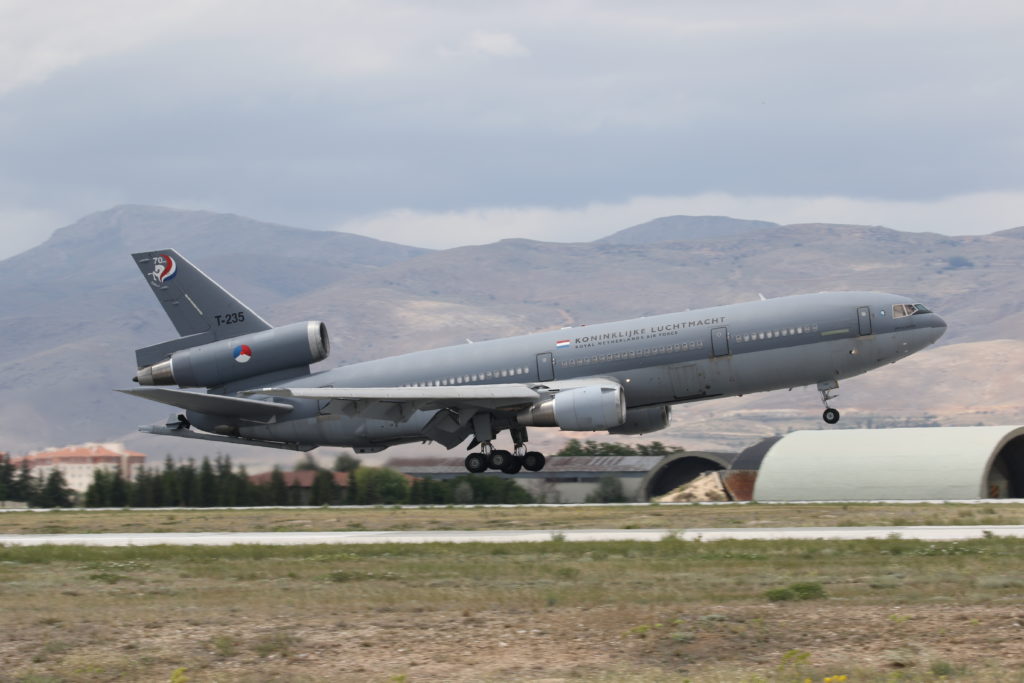
MMF
Well now there is a solution for countries like Hungary and Czech Republic which means they will not have to buy their own tankers. Instead they can buy flying hours from a NATO/EU fleet of A330 MRTTs.
In 2016, NATO & EU leaders signed a Joint Declaration document that mandated greater inter-organisational cooperation. Under strategic guidance it is developing ‘coherent, complementary & interoperable defence capabilities’ which included AAR. Improvements were set to be made in three areas: the procurement of new assets via the Multinational Multi-Role Tanker Transport Fleet (MMF); optimising existing capabilities, including purchasing more A400M air refuelling kits; increasing capability by developing procedures for AAR clearances.
This should revolutionise NATO’s Air to Air Refuelling (AAR) system. MMF is a co-operative programme, involving three multinational agencies: NSPA (NATO Support and Procurement Agency), OCCAR-EA (Organisation for Joint Armament Cooperation – Executive Administration) and EDA (European Defence Agency). It is currently made up of five nations – Germany, Netherlands, Belgium, Luxembourg, and Norway, with the Czech Republic expected to join in late October. Lt Col Pavel Pavlik finished, “We hope to be part of a programme that will provide us a certain amount of hours per year, and as it’s multi role we can use it as a transport, too.”
The MMF has signed a multi-billion Euro deal for eight A330/KC-30M Multirole Tanker Transports (MRTTs) with options on another three. The Netherlands and Luxembourg became the launch customers in July 2016 when they signed for two aircraft. They should have been joined by Poland, but the Warsaw government pulled out a day or so before the contract was set to be signed. Poland prefers, seemingly, to work with USAF KC-135Rs through the Foreign Military Sales (FMS) channel. In September 2017, Germany and Norway signed up, which led to five more aircraft ordered and last year, Belgium joined which increased the order to eight.
NSPA are now hoping to sell more flying time and take on the options, as NSPA’s Director of Life Cycle Management, Rudolf Maus explained, “Another nation [he wouldn’t name] is buying into a ninth aircraft with a need for up to 1,000 hours. There are other nations interested too which could cover the tenth.”
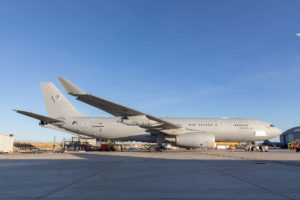
On 2 May 2020, the first A330 MRTT is set to be delivered to Eindhoven Air Base, Netherlands, with another four set to be delivered there over the next three years. Cologne, Germany acting as a forward operating base will house the other three MRTTs with the first arriving in October 2020. Maus continued: “Having two bases provides operational flexibility. If one base is not operational we can move into the other.”
Jan Der Kinderen, NATO NSPA’s System Manager MMF, told me how the decision to acquire the A330MRTT unfolded. “We looked at the market in 2015 and there was only one real multirole aircraft, and while it is true there was also the Boeing KC-46 it was not operational, and still isn’t. We wanted an aircraft that is truly multirole – air transport, medevac and air to air refuelling.”
Der Kinderen, who assumed his role on 1 February 2019, after vacating his role as Chairman of the MMF Support Partnership, continued, “It was the tanker of our choice and a little different from the VOYAGER configuration employed by the RAF. The UK has triple hose and drogues, which includes the central station – but many of the participating nations have aircraft that required boom receivers, so we needed a boom.”
Germany operates Panavia TORNADOs and EUROFIGHTERs that require a hose and drogue, but Netherlands, Belgium and Norway fly Lockheed Martin F-16s which call for a boom. All three will be fielding the Lockheed Martin F-35, which can also require a boom, thus extending the requirement for a boom system for years to come. The Czech Republic will also require a hose and drogue for its Saab JAS 39C/D GRIPENs.
Germany has signed up for 5,500 hours and with each aircraft allocated 1,100 hours per year, five aircraft were added to the fleet. Der Kinderen commented, “These are not sovereign assets. The nations don’t own them, but they have ‘assured access’ to the flying hours and the partner nations are the only ones that can use them. Most Air Chiefs would like their own assets, but from an efficiency point of view you need the mission, but you don’t need to own the assets. Some Air Chiefs might struggle with that.”
Netherlands will take up 2,000 hours a year, which is nearly two aircraft and as the A330MMRTs are controlled under Dutch military rules, all the aircraft will wear Royal Netherlands Air Force roundels and serial. Belgium will take 1,000 hours, Luxembourg 200 and Norway 100. When Czech Republic comes on board that will be another 100 hours, which will total 8,900 hours. “I know that’s just over eight aircraft” der Kinderen told the author, “but we can handle that.” Not all of the hours will of course be taken up by AAR. Many of the countries will use them for transport as well as medical evacuation, with Luxembourg particular interested in the latter.
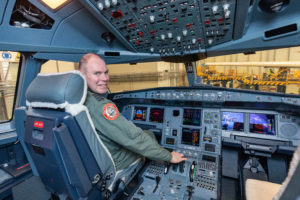
The first NATO A330, referred to as MMF-1, made its maiden flight on November 28, 2018 from Getafe, Spain where it was built. The two-engine aircraft is currently being used for training, aircraft qualifications, and receiver clearance. After being painted in its new livery at Manchester airport, the aircraft (to become T-054) departed back to Getafe on August to continue its flying programme. Der Kinderen continues: “The first four crews, two pilots and a boom operator, are currently undergoing ground training at [Airbus] Seville, Spain. They are from Germany, The Netherlands, and Belgium, the only three nations that provide flying staff.
The MMF flying unit, which is not part of any air force, is governed by a multinational executive board and they selected the commander and deputy commander as well as other key personnel. Aircrews have already been selected from the participating nations to fly the first three aircraft. Colonel Jurgen van der Biezen of the Royal Netherlands Air Force, took on the command of the MMF unit on 16 July 2019, is currently training on the A330MRTT in Seville.
Der Kinderen believes the MMF will be massively appealing to the smaller nations that cannot afford their own tankers. The Czech Republic is joining, which he hopes will be a catalyst for more nations. Hungary with its GRIPENs is another option, and Slovakia as well when it receives F-16s in 2023/24.
EATC
The European Air Transport Command, formed on 1 September 2010 is based at Eindhoven, conveniently co-located with the future MMF. It is tasked with three main roles: military air transport, air to air refuelling and aeromedical evacuation. There are currently only seven EU countries that own AAR assets but only five of them are EATC members: France, Germany, Italy, Netherlands and Spain. Since a dedicated AAR cell was created in 2014, it has become the single point of contact for the national commands and the respective AAR entities. Close cooperation and co-ordination with national AAR agencies has been set up in parallel. Its primary role is to enhance interoperability and to harmonise procedures, and as a result it has successfully pulled together a pool of aircraft which it can share when required.
The EATC currently has 20 air to air refuelling assets from France (three C-160NGs – drogue only, set to be replaced by two drogue equipped KC-130Js), Germany (two A310 MRTTs and one A400M that are drogue only), Italy (four KC-767s – boom and drogue and three KC-130Js – drogue only), The Netherlands (two KDC-10s – boom only) and Spain (five KC-130Hs – drogue only).
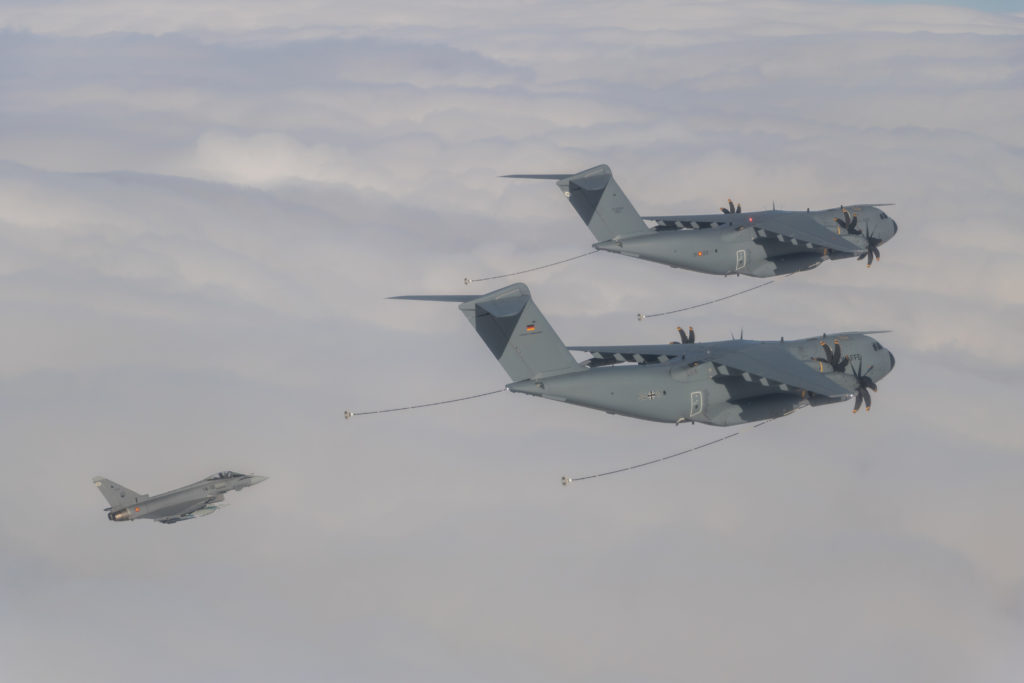
In 2018, more than 400 AAR missions were performed by assets from the EATC, which prioritises the available requests against available assets. For 2019, around 350 AAR missions had been executed by mid-September assisting aircraft from Belgium, Czech Republic, Finland, France, Germany, Italy, The Netherlands, Norway, Poland, Spain, Sweden, USA, UK, NATO’s Heavy Airlift Wing and NATO’s AEW&C force.
The Airbus A400M became available to the requirements of the EATC in early 2018 and in June, 2019 a roadmap for further integration of the four-engine transport aircraft, was announced. On the AAR front it will lead to more training co-operation. As more A400Ms are delivered with air refuelling kits, so the number of air to air refuelling assets will become available to the EATC. Germany is currently operating nine A400Ms configured for AAR kits, but only one is being used on daily operations. Another aircraft is detached to Al Azraq Air Base, Jordan to support the four reconnaissance-configured German Air Force TORNADO IDS and one TORNADO ECR supporting the war against Islamic militants in Iraq and Syria. The A400M has only recently taken over the role from a A310 MRTT, which are expected to be withdrawn from use when Germany, is running all its new A330 MRTTs. Spain is also believed to be interested in acquiring AAR kits for its A400Ms. France, upset with the slow progress of the A400M ordered two KC-130Js in 2017, which led to the first one being delivered on September 20. The French and German Air Force are set to acquire four KC-130Js between them, which will be based as a combined unit at Orleans, France.
The German and Spanish A400Ms along with the French and German KC-130Js assets will augment the eight MMF A330MRTTs, four Italian Boeing 767s and three Italian Air Force C-130Js. The first Royal Netherlands Air Force KDC-10 is expected to be retired at the end of the year and the second will follow in 2021. The introduction of a new generation tanker fleet (A400M and A330 MRTT), will see the air-to-air refuelling domain edging closer to EATC’s core business of military air transport. The EATCs current expertise is helping to deliver a centre piece for air-to-air refuelling related matters for member nations.
Command of the EATC rotates between Germany and France. Major General Laurent Marboeuf of the French Air Force took over in September 2018. In one of his first speeches, Marboeuf spoke of the implementation of a multinational MRTT unit, achieving full AAR capability for the A-400Ms and the arrival of new C-130Js, that will see the AAR fleet under EATC authority tripled within just a few years. Allowing increased interoperability between the partners.”. Marboeuf will be replaced by a German Air Force commander in September 2020.
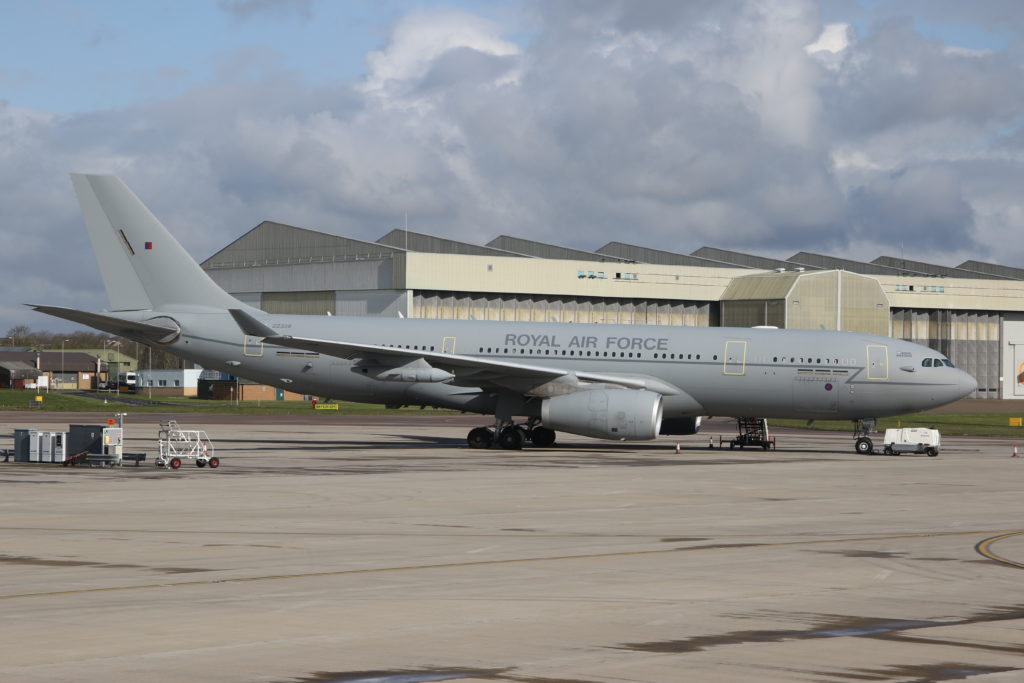
To meet the training needs of NATO and its allies, a multinational AAR training exercise, known as European Air Refuelling Training (EART) is run on a yearly basis from Eindhoven. This year’s EART 2019, was pooled once again with the Dutch Frisian Flag multinational fighter exercise. During the two-week duration, 60 fighters and five tankers (Royal Netherlands Air Force KDC-10, German Air Force A310MRTT, USAF/100th ARW KC-135R, French Air Force KC-135FR and RAF/Air Tanker A330MRTT) trained in a limited 74,000 sq km of air space. Such training offers the crews unique opportunities, with the tankers requested to train impressive quick turnaround executions in barely one hour – a more than challenging training for both the aircrews and the logistic support.
EATC is looking at the prospect of training together with a major multinational fighter exercise in a bigger and less congested airspace, and is discussing different scenarios to be trained in future. In 2020, for the first time, a MMF A330 MRTT will participate in EART.
UK’s Air Tanker
The RAF’s VOYAGER Force based at RAF Brize Norton has now been flying for seven years. It is run by AirTanker, a consortium of Airbus Group, Rolls-Royce, Thales, Cobham and Babcock, after being awarded a £13Bn (US$25.8Bn) Private Finance Initiative contract on 27 March 2008 to run 27 years. It is the biggest fleet of tankers in Europe but does not contribute aircraft to the EATC. AirTanker has a fleet of 14 brand new Airbus A330MRTTs, that includes nine aircraft for air-to-air refuelling and air transport. The ninth has no under-wing pods, carries a civil registration and no RAF roundels and is used for the Falkland Islands air-bridge flown by AirTanker crews. The additional five make up the surge fleet. These would be made available to the RAF at its request, or potentially in the future to allies. Until that time the surge aircraft can be leased by AirTanker to the civil market. Of the nine military registered aircraft, three VOYAGERs are configured as KC2s, with two Cobham 905 under-wing pods, which are used for refuelling fast jets. Five are configured as KC3s, fitted with the Cobham Fuselage Refuelling Unit (FRU) to create a centreline refuelling capability, primarily to give fuel to large aircraft. All of the eight military registered aircraft have the ability to be configured as either a KC2 or KC3.
Having the ability to refuel two receiver aircraft from its wing pods simultaneously, VOYAGER gives the RAF a large capacity two-point tanking capability with a maximum flow from each wing pod of just over a ton (1,200 kg) a minute and two tonnes (1,800 kg) a minute on the centreline.
Meanwhile, the five VOYAGERs that are being made available in the charter market have to be de-militarised. This will see them having their AAR equipment including the under-wing pods and the Cobham FRUs removed at RAF Brize Norton and the aircraft reverting to A330-243s. One has so far been chartered to Thomas Cook. The VOYAGERs are being flown by two squadrons – 10 Squadron and 101 Squadron – which although separate entities, are interoperable. There is always one VOYAGER in the Falklands, which can provide support to the 1435 Flight TYPHOONs on Quick Reaction Alert (QRA) down there and provides an aero-med standby. There is also a VOYAGER on alert at Brize Norton to support TYPHOONs if called into QRA action from RAF Lossiemouth in Moray, Scotland or RAF Coningsby, Lincs which are regularly occurrences these days because of Russian Air Force activity. Like the MMF the Voyagers have a fuel capacity of 111 tonnes although they usually only operate with around 100 tonnes and if it runs short of fuel itself can be topped up by another tanker.
Alan Warnes is a journalist specialising in military aviation and has travelled to over 60 countries researching articles and taking action photos for his work. For 12 years, he was the Editor of AirForces Monthly. He has also written several books, including two on the Pakistan Air Force (in 2008 and 2017), and most recently on 100 years of Aero Vodochody.





